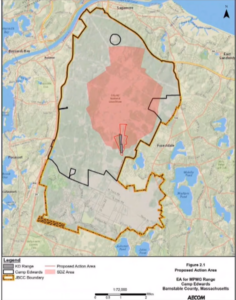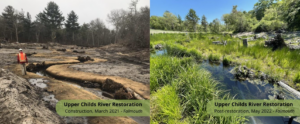
HYANNIS – While recent precipitation has improved conditions statewide, the Cape and Islands remain in a mild drought.
The past few months has seen unprecedented wildfires and general fire risk, according to Energy and Environmental Affairs Secretary Rebecca Tepper.
The recent review shows Cape Cod as the only area where groundwater is decreasing, though it is still within normal ranges.
“Seeing drought conditions improve across nearly all our regions is encouraging. That said, we need to continue practicing indoor water conservation to fully recover and reduce future drought impacts,” said Energy and Environmental Affairs Secretary Rebecca Tepper in a statement.
“I want to recognize everyone who has been helping us combat the unprecedented wildfires and drought conditions over the past several months. We continue to express our gratitude to those first responders and ask everyone to exercise caution in their water use.”
The following is the full statement from the Executive Office of Energy and Environmental Affairs:
Following several weeks of snow and rain, Energy and Environmental Affairs Secretary Rebecca Tepper declared the Central, Northeast, and Connecticut River Valley regions will be downgraded from a Level-3 Critical Drought to a Level-2 Significant Drought. The Western and Southeast Regions will also move from a Level-3 Critical Drought to a Level-1 Mild Drought status due to improved conditions. The Cape and Islands regions remain in a Level-1 Mild Drought.
As outlined in the Massachusetts Drought Management Plan, a Level 2-Signifcant Drought and a Level-1 Mild Drought require detailed monitoring of drought conditions, continued coordination among state and federal agencies to advance the implementation of water use restrictions, engagement with municipalities, including local Boards of Health, providing technical outreach and assistance to water suppliers and affected municipalities.
“Seeing drought conditions improve across nearly all our regions is encouraging. That said, we need to continue practicing indoor water conservation to fully recover and reduce future drought impacts,” said Energy and Environmental Affairs Secretary Rebecca Tepper. “I want to recognize everyone who has been helping us combat the unprecedented wildfires and drought conditions over the past several months. We continue to express our gratitude to those first responders and ask everyone to exercise caution in their water use.”
Over the past month, most of the state received between 3-6 inches of rain and snow, and 6-8 inches in the southeast region. This precipitation is important for restoring normal conditions after last year’s severe drought and fire risks. Despite the recent rain and snowfall, streamflow remains low in the Northeast, Central, and Connecticut River Valley regions. Groundwater levels are also improving in all areas, except on the Cape where groundwater is decreasing, even though it is in the normal range. Residents can report dry environmental conditions they are experiencing and submit photos to support state drought monitoring efforts here.
The Massachusetts Department of Environmental Protection (MassDEP) will continue to provide technical assistance to communities on managing their water systems, including assistance on the use of emergency connections and water supplies.
It is important to note that the Massachusetts Water Resources Authority (MWRA) water supply system is not experiencing drought conditions, as defined within its individual plan. However, private well users and other sources of water within the same river basins are impacted by drought conditions. All sources of water, regardless of their location or type of withdrawal, ultimately draw from the same river basin. It is essential for all users to do their part to conserve water.
Below are recommendations for communities and individuals living and working within a Level 2 – Significant Drought and Level 1 – Mild Drought region, including those utilizing a private well. Residents and businesses are also asked to check with their local water system in case more stringent watering restrictions are in place.
For Regions in Level 2 – Significant Drought
Residents and Businesses:
- Minimize overall water use and be particularly mindful of indoor water use.
- Follow local water use restrictions
- Fix indoor leaks, such as from toilets, faucets, and showers, which result in more than 60 percent of indoor use;
- For larger buildings and businesses, conduct water audits to identify areas of leaks and potential water conservation opportunities.
Immediate Steps for Communities/Municipalities:
- Limit or prohibit washing of hard surfaces (sidewalks, patios, driveways, siding); personal vehicle or boat washing.
- Establish water-use reduction targets for all water users, identify top water users and conduct targeted outreach to help curb their use.
Short- and Medium-Term Steps for Communities/Municipalities:
- Establish a year-round water conservation program that includes public education and communication, taking advantage of the state’s library of outreach materials.
- Provide timely information to local residents and businesses.
- Implement or establish drought surcharge or seasonal water rates.
- Check emergency inter-connections for water supply.
- Develop or refine your local drought management plan using guidance outlined in the state Drought Management Plan.
Below are recommendations for communities and individuals living and working within a Level 1 – Mild Drought region.
For Region in Level 1 – Mild Drought
Residents and Businesses:
- Minimize overall water use;
- Fix indoor leaks, such as from toilets, faucets, and showers, which result in more than 60 percent of indoor use;
- For larger buildings and businesses, conduct water audits to identify areas of leaks and potential water conservation opportunities;
Communities/Municipalities:
- Establish a year-round water conservation program that includes public education and communication, taking advantage of the state’s library of outreach materials;
- Provide timely drought and water conservation information to local residents and businesses;
- Check emergency inter-connections for water supply; and
- Develop a local drought management plan (learn more here).
State agencies will continue to closely monitor and assess conditions across the state, coordinate any needed dissemination of information to the public, and help federal, state, and local agencies prepare additional responses that may be needed in the future. The Drought Management Task Force will meet again on Thursday, February 6, 2025 at 10:00 AM. For further information on water conservation and what residents can do, visit the EEA’s drought and water conservation pages.























